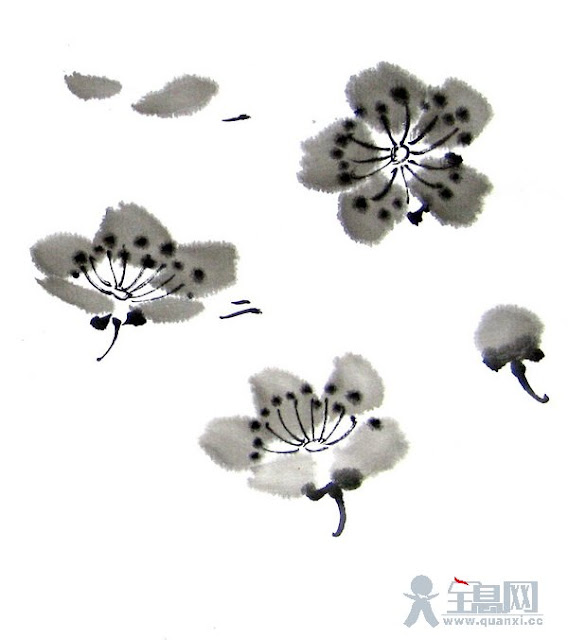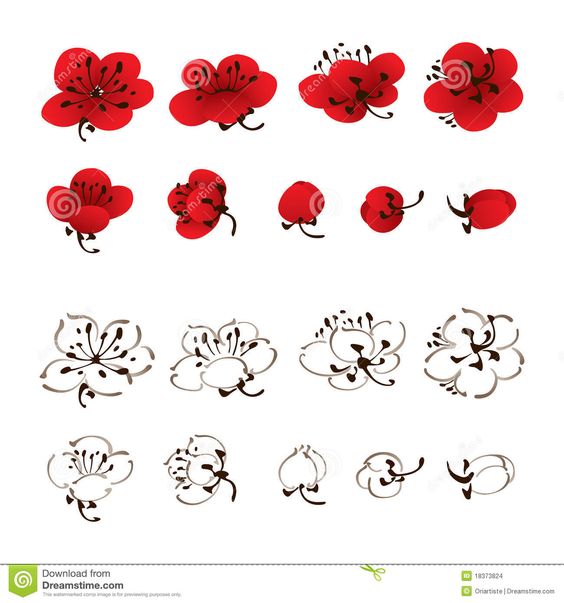Chinese Painting:
Objective:
1. Students will demonstrate knowledge of the Chinese painting methods, materials, and brush techniques to create a Chinese painting.
2. Students will demonstrate knowledge of the elements and principles of design.
3. Students will demonstrate their understanding of styles, stylistic influence, and stylistic change by identifying when and where artworks were created, and by analyzing characteristic features of artworks from various historical periods, cultures, and genres.
Chinese Painting Examples
The bamboo is the symbol of summer but also of strength, both physical and mental, as it will bend and sway in the severest of gales but does not break. Its hollow trunk means humility. Bamboo, together with plum blossom and pine are also known as the ‘Three Friends in Winter’, as pine and bamboo are evergreens and the plum blooms in the cold.
The chrysanthemum, which represents autumn, is thought of as a happiness and vitality, preferring autumn, which is less crowded with flowers than the profusion in spring.
Simplify, arrange the composition tips of off-center, crop out, rotation. Leave emptiness space for writing and bunny / animal.
How to paint Bamboos
Branches
Flowers- Bone drawing
Flowers- No Bone Painting
The arrangement of the fowers
Composition- Space and the Emptiness
Bird
Objective:
1. Students will demonstrate knowledge of the Chinese painting methods, materials, and brush techniques to create a Chinese painting.
2. Students will demonstrate knowledge of the elements and principles of design.
3. Students will demonstrate their understanding of styles, stylistic influence, and stylistic change by identifying when and where artworks were created, and by analyzing characteristic features of artworks from various historical periods, cultures, and genres.
Six principles of Chinese Painting
1. " Spirit of Mind,"-Painting from the “mind and heart” was to connect the artist to nature. ( The link between the inner nature with outer nature) ( Zen)
Three major categories in Chinese painting:
- Landscape (山水)
- Figure (人物)
- Bird and Flower (花鳥)
2. Brush Technique. similar to learning how to write calligraphy, painters had to learn particular brush strokes to create forms. A simple stroke had to be right.
3. Symbolic of the Object. The artist did not look at a subject but represented it as a form (symbolic expression). For example, the whole plant may not be painted, but rather a few blossoms to represent the whole plant.
5. The application of color in tones and values. Host- largest, strongest and darker part of the object. Guests- smaller and lighter.
6. The copying of masterworks, not only from life but also the works of antiquity. Copying other artists were encouraged.
Chinese Painting Examples 
The Four Gentlemen
The plum blossom, representing winter, is also symbolic of endurance as it often flowers when the snow is still on the ground. The flowers, which may be pink or white, appear before the leaves and this is how they are depicted in paintings.
The symbol of spring is the orchid, which represents spring, also signifies virtue and simple beauty. It is the delicate wild orchids that are referred to as they tend to grow in inaccessible areas such as crevices in rocks overlooking rivers or streams, and you could easily walk past without noticing them.
The bamboo is the symbol of summer but also of strength, both physical and mental, as it will bend and sway in the severest of gales but does not break. Its hollow trunk means humility. Bamboo, together with plum blossom and pine are also known as the ‘Three Friends in Winter’, as pine and bamboo are evergreens and the plum blooms in the cold.
The chrysanthemum, which represents autumn, is thought of as a happiness and vitality, preferring autumn, which is less crowded with flowers than the profusion in spring.
Keep in mind:
1. use a Camellia Japonice 山茶花 reference
2. Simplify the reference to 3-5 branches
3. Draw 3-8 flowers that includes one full top view of a flower, one side view of the flower. Arrange all flowers in different directions.
4. Composition of the drawing should demonstrate the following components : off the center, rotation, crop out, and emptiness.
5. When using ink must demonstrate different brusk strokes
6. Must demonstrate the application of colors in tones and values.
The picture you may find online
Simplify, arrange the composition tips of off-center, crop out, rotation. Leave emptiness space for writing and bunny / animal.
Bamboo
The bamboo is the symbol of summer but also of strength, both physical and mental, as it will bend and sway in the severest of gales but does not break. Its hollow trunk means humility.
- Bamboo Stalks: 3 or 4; different thickness; less ink/water; fast speed( you can see a part of bamboo has empty space); light value ink; not in the center
- Stalk notches: thin bend line( not straight); darker ink line ( not straight)
- Branches: thin line; medium darkness ink;
- Leaves: strong ink; slow speed; Start with a pointy line end with a point.
The Story of Bamboo
Well layout Composition + animal
Off center
Rotation
Crop out
Student's Examples:
How to Sketch Bamboos
How to paint Bamboos
Sketch
Bamboo Painting 1
Bamboo Painting 2
Bamboo Painting 3
Bamboo Stalks Practice
Bamboo Knots Practice
Bamboo Branches Practice
Bamboo Leaves Practice
Penda 4:50
Penda 4:50
Branches and plum blossom
Flowers- Bone drawing
Flowers- No Bone Painting
The arrangement of the fowers
Composition- Space and the Emptiness
Chrysanthemum
The Orchid
Bamboo
- Bamboo Stalks: 3 or 4; different thickness; less ink/water; fast speed( you can see a part of bamboo has empty space); light value ink; not in the center
- Stalk notches: thin bend line( not straight); darker ink line ( not straight)
- Branches: thin line; medium darkness ink;
- Leaves: strong ink; slow speed; Start with a pointy line end with a point.
The Story of Bamboo
Student's Examples:
Bamboo Painting 1
Bamboo Painting 2
Bamboo Painting 3
Panda
Bird
Butterfly
Bamboo Stalks Practice
Bamboo Knots Practice
Bamboo Branches Practice
Bamboo Leaves Practice
Penda 4:50
Penda 4:50


























































































